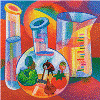Chemical and Biomolecular Engineering, Department of: Papers in Subdisciplines

Papers in Biotechnology
Affinity Purification of Biologically Active andInactive Forms of Recombinant Human Protein C Produced in Porcine Mammary Gland
Date of this Version
9-1-1996
Abstract
Recombinant human protein C (rhPC) secreted in the milk of transgenic pigs was studied. 'Ikansgenes having different regulatory elements of the murine milk protein, whey acidic protein, were used with cDNA and genomic human protein C (hPC) DNA sequences to obtain lower and higher expressing animals. The cDNA pigs had a range of expression of about 0.1-0.5 g/l milk. Two different genomic hPC pig lines have expressed 0.3 and 1-2 g/l, respectively. The rhPC was first purified at yields greater than 60 per cent using a monoclonal antibody (mAb) to the activation site on the heavy chain of hPC. Subsequent immunopurification with a calcium-dependent mAb directed to the y-carboxyglutamic acid domain of the light chain of hPC was used to fractionate a population having a higher specific anticoagulant activity in vW. The higher percentages of Ca2+-dependent conformers isolated from the total rhPC by immunopurification correlated well with higher specific activity and lower expression. A rate limitation in y-carboxylation of rhPC was clearly identified for the higher expressing animals. Thus, transgenic animals with high expression levels of complex recombinant proteins produced a lower percentage of biologically active protein.


Comments
Originally Published in JOURNAL OF MOLECULAR RECOGNITION, VOL. 9.407-414 (1996): This Articale can be viewd at: http://www3.interscience.wiley.com/cgi-bin/fulltext/22664/PDFSTART